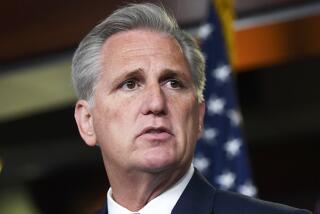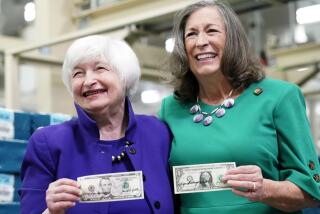U.S., 15 Other Nations Act to Bolster Dollar
- Share via
WASHINGTON — Plunging aggressively into volatile currency markets, the Clinton Administration moved Wednesday to prop up the value of the steadily slipping dollar and head off a potential threat to the struggling global economic recovery.
The Treasury Department and Federal Reserve, coordinating their measures with 15 other nations, moved in concert for the first time since President Clinton took office to prevent the dollar from weakening further against the Japanese yen and the German mark.
In New York, the dollar closed at 1.654 German marks, up from 1.637 marks on Tuesday. The dollar also rose to 101.85 yen, up from 101.05 yen late Tuesday.
Since the end of 1993, the dollar’s value has slumped from a high of 1.738 marks and 111.6 yen.
In the short run, the action could make imports from these two major manufacturing nations less expensive in the United States. And in the longer run--if successful--it could restore stability and predictability to the international currency trading picture.
The dollar has been losing value all week, despite a much more limited intervention in currency markets Friday. In recent days it has been flirting with a historic low against the yen and a six-month low against the mark.
The declining dollar placed the Clinton Administration in a “damned if you do, damned if you don’t” predicament.
If investors expect the dollar to lose value, they hesitate to put their money into the United States. That cuts down the flow of much-needed foreign capital to U.S. financial institutions.
But a strong dollar brings problems of its own, tending to worsen the nation’s trade deficit. That is because it boosts the price of U.S. products bought with foreign currencies overseas. Conversely, it makes imports cheaper in the United States. That might be good news for consumers but it damages the ability of U.S. manufacturers to compete with foreign rivals in price.
For now, the Administration has decided that propping up the dollar’s value is the lesser evil.
Treasury Secretary Lloyd Bentsen, highlighting the significance of the move by taking the unusual step of publicly announcing it, said Wednesday’s actions “reflect our view that recent movements in exchange markets have gone beyond what is justified by economic fundamentals.”
Bentsen sought to make it clear that the United States was not trying to drive down its trade deficit by letting the dollar slide. “This Administration sees no advantage in an undervalued currency,” he said.
The dollar has been sagging even though U.S. interest rates have been rising.
Higher rates usually make the dollar a more attractive investment for money managers, and growing demand pushes the dollar’s value up.
But for now, investors seem to have discounted the effect of rising U.S. interest rates, and, with U.S.-Japanese trade talks stalled, analysts said there was little else to promote long-term confidence in the dollar.
Most private analysts found Wednesday’s coordinated intervention in the currency markets significant.
“For the first time,” said Marc Hendrix, head of research at the Swiss Bank Corp. in London, “central banks have become concerned about the dollar’s decline and the potential for a mini-crisis. It is significant in terms of restoring some order or stalling the dollar’s decline.”
The intervention was accomplished through a massive sale of other currencies for dollars, a move designed to drive up the dollar’s value much as a large purchase of stock can drive up the value of remaining shares.
The specific amount of purchases was not disclosed but it was believed to involve several billion dollars.
The step had the desired effect of driving up the dollar’s value, if only temporarily. But the dollar began to slip again by the end of the day.
Senior Treasury officials said the intervention was meant to counteract what was described as “a negative psychology that had developed on the basis of false perceptions that the United States was trying to drive the dollar down for reasons of competitiveness and leverage.” They said the United States is “not indifferent to where market forces took the value of the dollar.”
Republicans in Congress warned that, with an estimated trillion dollars washing through international currency markets every day, foreign governments could not influence currency values for long.
Rep. Jim Leach of Iowa, ranking Republican on the House Banking, Finance and Urban Affairs Committee, called the intervention “a risky sideshow--risky in the sense that taxpayer funds are being used as a hedge fund; a sideshow to the extent that any effect is likely to be short term: hours, days, perhaps weeks.”
“The only sustaining governmental action that can bolster a currency relates to long-term political and monetary discipline, not to transitory political manipulation,” Leach said.
C. Fred Bergsten, a senior Treasury official in the Jimmy Carter Administration and now director of the Institute for International Economics, said the Clinton Administration was making “a mistake, based on a fear we might get a large dollar decline that might drive the bond market down further. I see little evidence of that.”
* RISING RATES: Lawmakers criticize the Federal Reserve’s interest rate hikes, while a Southland business deals with the impact. D1
More to Read
Inside the business of entertainment
The Wide Shot brings you news, analysis and insights on everything from streaming wars to production — and what it all means for the future.
You may occasionally receive promotional content from the Los Angeles Times.










